Land Use and Land Cover Change and Potential Implications for Water Levels of the Great Salt Lake
Abstract
1. Introduction
2. Materials and Methods
2.1. Climate Data
2.2. National Land Cover Dataset
2.3. Cropscape Dataset
2.4. Water Use Data
2.5. Normalized Difference Vegetation Index Study to Infer Grassland Water Use
3. Results and Discussion
3.1. Climate Trends for Salt Lake City 1985–2023
3.2. Changes in Land Use Based on Landsat National Land Cover Dataset
3.3. Changes in Municipal and Irrigation Water Use Resulting from Changes in Crops/Land Use
3.4. Spatial Differences in Land Use Land Class Changes
3.5. Study Limitations
4. Conclusions
Supplementary Materials
Author Contributions
Funding
Data Availability Statement
Acknowledgments
Conflicts of Interest
References
- Rakhmanov, S.; Fayzullaeva, N. Aral Sea Crisis and Water Management in Central Asia. BRICS Law J. 2025, 12, 151–166. [Google Scholar]
- Goudie, A. Dust storms and ephemeral lakes. Desert 2018, 23, 153–164. [Google Scholar]
- Cahill, T.A.; Gill, T.E.; Reid, J.S.; Gearhart, E.A.; Gillette, D.A. Saltating particles, playa crusts and dust aerosols at Owens (dry) Lake, California. Earth Surf. Process. Landf. 1996, 21, 621–639. [Google Scholar] [CrossRef]
- Frie, A.L.; Dingle, J.H.; Ying, S.C.; Bahreini, R. The effect of a receding saline Lake (the Salton Sea) on airborne particulate matter composition. Environ. Sci. Technol. 2017, 51, 8283–8292. [Google Scholar] [CrossRef]
- Saint-Armand, P.; Mathews, L.A.; Gaines, C.; Roger, R. Dust Storms from Owens and Mono Valleys, California; Report No. NWC-TP-6731; Naval Weapons Center: China Lake, CA, USA, 1986. [Google Scholar]
- Ono, D.; Kiddoo, P.; Howard, C.; Davis, G.; Richmond, K. Application of a combined measurement and modeling method to quantify windblown dust emissions from the exposed playa at Mono Lake, California. J. Air Waste Manag. Assoc. 2011, 61, 1036–1045. [Google Scholar] [CrossRef] [PubMed]
- Gill, T.E. Eolian sediments generated by anthropogenic disturbance of playas: Human impacts on the geomorphic system and geomorphic impacts on the human system. Geomorphology 1996, 17, 207–228. [Google Scholar] [CrossRef]
- AghaKouchak, A.; Norouzi, H.; Madani, K.; Mirchi, A.; Azarderakhsh, M.; Nazemi, A.; Nasrollahi, N.; Farahmand, A.; Mehran, A.; Hasanzadeh, E. Aral Sea syndrome desiccates Lake Urmia: Call for action. J. Great Lakes Res. 2015, 41, 307–311. [Google Scholar] [CrossRef]
- Indoitu, R.; Kozhoridze, G.; Batyrbaeva, M.; Vitkovskaya, I.; Orlovsky, N.; Blumberg, D.; Orlovsky, L. Dust emission and environmental changes in the dried bottom of the Aral Sea. Aeolian Res. 2015, 17, 101–115. [Google Scholar] [CrossRef]
- Karami, S.; Hamzeh, N.H.; Kaskaoutis, D.G.; Rashki, A.; Alam, K.; Ranjbar, A. Numerical simulations of dust storms originated from dried lakes in central and southwest Asia: The case of Aral Sea and Sistan Basin. Aeolian Res. 2021, 50, 100679. [Google Scholar] [CrossRef]
- Abuduwaili, J.; Gabchenko, M.V.; Xun, J. Eolian transport of salts-a case study in the area of Lake Ebinur (Xinjiang, Northwest China). J. Arid Environ. 2008, 72, 1843–1852. [Google Scholar] [CrossRef]
- Salameh, E.; El-Naser, H. Restoring the Shrinking Dead Sea—The Environmental Imperative—. In Climatic Changes and Water Resources in the Middle East and North Africa; Zereini, F., Hötzl, H., Eds.; Environmental Science and Engineering; Springer: Berlin/Heidelberg, Germany, 2008. [Google Scholar]
- Satgé, F.; Espinoza, R.; Zolá, R.P.; Roig, H.; Timouk, F.; Molina, J.; Garnier, J.; Calmant, S.; Seyler, F.; Bonnet, M.-P. Role of Climate Variability and Human Activity on Poopó Lake Droughts Between 1990 and 2015 Assessed Using Remote Sensing Data. Remote Sens. 2017, 9, 218. [Google Scholar] [CrossRef]
- Abbott, B.W.; Baxter, B.K.; Busche, K.; de Freitas, L.; Frei, R.; Gomez, T.; Karren, M.A.; Buck, R.L.; Price, J.; Frutos, S.; et al. Emergency Measures Needed to Rescue Great Salt Lake from Ongoing Collapse. 2023. Available online: https://pws.byu.edu/GSL%20report%202023 (accessed on 30 May 2024).
- Metzger, J.; Nied, M.; Corsmeir, U.; Kleffmann, J.; Kottmeier, C. Dead Sea evaporation, energy budget, Priestly-Taylor and penman estimates. Hydrol. Earth Sys. Sci. 2018, 22, 1135–1155. [Google Scholar] [CrossRef]
- Vey, S.; Al-Halbouni, D.; Haghighi, M.H.; Alshawaf, F.; Vüllers, J.; Güntner, A.; Dick, G.; Ramatschi, M.; Teatini, P.; Wickert, J.; et al. Delayed subsidence of the Dead Sea shore due to hydro-meteorological changes. Sci. Rep. 2021, 11, 13518. [Google Scholar] [CrossRef]
- Levy, D.B.; Schramke, J.A.; Esposito, K.J.; Erickson, T.A.; Moore, J.C. The shallow ground water chemistry of arsenic, fluorine, and major elements: Eastern Owens Lake, California. Appl. Geochem. 1999, 14, 53–65. [Google Scholar] [CrossRef]
- Wu, N.; Ge, Y.; Abuduwaili, J.; Issanova, G.; Saparov, G. Insights into variations and potential long-range transport of atmospheric aerosols from the Aral Sea basin in Central Asia. Remote Sens. Lett. 2022, 14, 3201. [Google Scholar] [CrossRef]
- Utah Division of Water Resources. 2025. Available online: https://water.utah.gov/great-salt-lake/#:~:text=Great%20Salt%20Lake%20is%20the,between%20North%20and%20South%20America (accessed on 1 October 2025).
- Rusnak, K.; Smith, P.; Moss, S.; Wester, M.; Grammar, A.; Hunt, H. Understanding the Great Salt Lake Shrinkage: Stakeholders, Current Efforts, and Research Gaps. 2024. Available online: https://ballardcenter.byu.edu/00000196-caec-dd5d-a7de-dfeeb5280000/the-current-state-of-great-salt-lake (accessed on 30 August 2025).
- Huggett, R.; Shuttleworth, E. Fundamentals of Geomorphology, 5th ed.; Routledge: London, UK, 2023; p. 624. [Google Scholar]
- Utah Geological Survey. Commonly Asked Questions About Utah’s Great Salt Lake & Lake Bonneville—Utah Geological Survey. 2023. Available online: https://geology.utah.gov/popular/great-salt-lake/commonly-asked-questions/#toggle-id-12 (accessed on 15 July 2025).
- NASA Salinity: Role of Salt. Available online: https://salinity.oceansciences.org/learn-salt.htm (accessed on 15 August 2025).
- Brooks, P.D.; Chorover, J.; Fan, Y.; Godsey, S.E.; Maxwell, R.M.; McNamara, J.P.; Tague, C. Hydrological partitioning in the critical zone: Recent advances and opportunities for developing transferable understanding of water cycle dynamics. Water Resour. Res. 2015, 51, 6973–6987. [Google Scholar] [CrossRef]
- Singh, M. Last nail in the coffin: Utah’s Great Salt Lake on verge of collapse. The Guardian, 10 January 2023. Available online: https://www.theguardian.com/environment/2023/jan/10/utah-great-salt-lake-collapse-imminent (accessed on 15 August 2025).
- Wurtsbaugh, W.A.; Sima, S. Contrasting Management and Fates of Two Sister Lakes: Great Salt Lake (USA) and Lake Urmia (Iran). Water 2022, 14, 3005. [Google Scholar] [CrossRef]
- Harvey, C. Climate Change Has Helped Fuel a Megadrought in the Southwest. E&E News, 17 April 2020. Available online: https://www.scientificamerican.com/article/climate-change-has-helped-fuel-a-megadrought-in-the-southwest/ (accessed on 15 August 2025).
- Coats, S.; Smerdon, J.E.; Cook, B.I.; Seager, R. Are Simulated Megadroughts in the North American Southwest Forced? J. Clim. 2015, 28, 124–142. [Google Scholar] [CrossRef]
- Williams, A.P.; Cook, E.R.; Smerdon, J.E.; Cook, B.I.; Abatzoglou, J.T.; Bolles, K.; Baek, S.H.; Badger, A.M.; Livne, B. Large contribution from anthropogenic warming to an emerging North American megadrought. Science 2020, 368, 314–318. [Google Scholar] [CrossRef]
- Wurstbaugh, W.; Miller, C.; Null, S.E.; Wilcock, P.R.; Hahnenberger, M.; Howe, F.P. Impacts of Water Development on Great Salt Lake and the Wasatch Front; Working Paper; Watershed Sciences Faculty Publications: Logan, UT, USA, 2016. [Google Scholar]
- Rupke, A. Utah’s Potash Resources and Activity. Utah Geological Survey. 2012. Available online: https://geology.utah.gov/map-pub/survey-notes/utahs-potash-resources-and-activity/ (accessed on 15 August 2025).
- Brine Shrimp Harvests. Utah Divison of Wildlife Resources. 2023. Available online: https://wildlife.utah.gov/gslep/harvests.html (accessed on 15 August 2025).
- Bioeconomics, Inc. Economic Significance of the Great Salt Lake to the State of Utah. Research Report Prepared for State of Utah Great Salt Lake Advisory Council. 2012. Available online: https://lf-public.deq.utah.gov/WebLink/ElectronicFile.aspx?docid=392799&eqdocs=DWQ-2012-006864&dbid=0&repo=Public (accessed on 15 August 2025).
- Baxter, B.K.; Butler, J.K. Great Salt Lake Biology: A Terminal Lake in a Time of Change; Springer: Berlin/Heidelberg, Germany, 2020; p. 947. [Google Scholar]
- Steenburgh, W.J.; Massey, J.D.; Painter, T.H. Episodic Dust Events of Utah’s Wasatch Front and Adjoining Region. J. Appl. Meteor. Climatol. 2012, 51, 1654–1669. [Google Scholar] [CrossRef]
- Lang, O.; Mallia, D.; Skiles, M. The Shrinking Great Salt Lake Contributes to Record High Dust-on-Snow Deposition in the Wasatch Mountains During the 2022 Snowmelt Season. Environ. Res. Lett. 2023, 18, 064045. [Google Scholar] [CrossRef]
- Brooks, P.D.; Gelderloos, A.; Wolf, M.A.; Jamison, L.R.; Strong, C.; Solomon, D.K.; Bowen, G.J.; Burian, S.; Tai, X.; Arens, S.; et al. Groundwater-mediated memory of past climate controls water yield in snowmelt-dominated catchments. Water Resour. Res 2021, 57, e2021WR030605. [Google Scholar] [CrossRef]
- Sowby, R.B. Terminus: A Hydrobiographic Journey of Water Management in the Great Salt Lake Basin; Twin Peaks Press: American Fork, UT, USA, 2025. [Google Scholar]
- Utah Division of Natural Resources, 2021 Water Resources Plan (Salt Lake City: Utah Department of Natural Resources). 2021. Available online: https://water.utah.gov/2021waterplan/ (accessed on 15 August 2025).
- Barker, B.; Yost, M.; Zesiger, C. Agricultural Irrigated Land and Irrigation Water Use in Utah; Utah State University Extension: Logan, UT, USA, 2022; Available online: https://extension.usu.edu/irrigation/research/agricultural-irrigated-land-and-water-use (accessed on 1 July 2024).
- Owen, D. Where the Water Goes: Life and Death Along the Colorado River; Riverhead: New York, NY, USA, 2017; p. 288. [Google Scholar]
- Maffly, B.; Eddington, M. One Crop Uses More Than Half of Utah’s Water, Here’s Why. Salt Lake Tribune, 13 March 2023. Available online: https://www.sltrib.com/news/environment/2022/11/24/one-crop-uses-more-than-half/ (accessed on 1 August 2025).
- Zesiger, C.; Barker, B.; Null, S.; Creech, E.; Yost, M.; Larsen, R.; Dallin, J. Agriculture Water Use and Economic Value in the Great Salt Lake Basin [Fact Sheet]; Utah State University Extension: Logan, UT, USA, 2023. [Google Scholar]
- Richter, B.; Kendall, B.; Dugan, J.; Getacho, G.; LaRoe, N.; Moro, B.; Rynne, T.; Tahamtani, M.; Townsend, A. Decoupling Urban Water use and Growth in Response to Water Scarcity. Water 2020, 12, 2868. [Google Scholar] [CrossRef]
- Perlich, P.S.; Hollingshaus, M.; Harris, E.R.; Tennert, J.; Hogue, M.T. Utah’s Long-Term Demographic and Economic Projections Summary; Kem C. Gardner Policy Institute, The University of Utah: Salt Lake City, UT, USA, 2017; Available online: https://gardner.utah.edu/wp-content/uploads/Projections-Brief-Final.pdf (accessed on 1 July 2024).
- Kem, C. Gardner Policy Institute, Utah Population Reaches Estimated 3,343,552 People, Net In-Migration Surges. In Census 2020: Utah Fastest Growing State in the US; Kem C. Gardner Policy Institute, The University of Utah: Salt Lake City, UT, USA, 2021; Available online: https://gardner.utah.edu/news/utah-population-reaches-estimated-3343552-people-net-in-migration-surges/#:~:text=Gardner%20Policy%20Institute%2C%20indicate%20the,is%20the%20highest%20since%202017 (accessed on 27 August 2025).
- Banta, M. Utah Cities Added Hundreds of Thousands of People in a Decade. Salt Lake Tribune, 4 August 2023. Available online: https://www.sltrib.com/news/2023/08/04/most-utahs-growth-happens-1-its/ (accessed on 13 April 2024).
- Kerry, R.; Ingram, B.; Sanders, K.; Henrie, A.; Hammond, K.; Hawks, D.; Hansen, N.; Jensen, R.; Hopkins, B. Precision Turfgrass Irrigation: Capturing Spatial Soil Moisture Patterns with ECa and Drone Data. Agronomy 2024, 14, 1238. [Google Scholar] [CrossRef]
- Gibson, J.; Bryan, K.; Guo, Y. Effects of Relaxed Minimum Pipe Diameters on Fire Flow, Cost, and Water Quality Indicators in Drinking Water Distribution Networks. J. Water Resour. Plann. Manag. 2020, 146, 8. [Google Scholar] [CrossRef]
- Yañez-Barnuevo, M. Data Centers and Water Consumption. 2025. Available online: https://www.eesi.org/articles/view/data-centers-and-water-consumption (accessed on 2 October 2025).
- Lee, L.Y.; Kerry, R.; Ingram, B.; Golden, C.S.; LeMonte, J.J. Investigating the Spatial Patterns of Heavy Metals in Topsoil and Asthma in theWestern Salt Lake Valley, Utah. Environments 2024, 11, 223. [Google Scholar] [CrossRef]
- NOAA. 2025. Available online: https://www.ncei.noaa.gov/ (accessed on 5 October 2025).
- U.S. Geological Survey (USGS). Annual NLCD Collection 1 Science Products: U.S. Geological Survey Data Release. 2024. Available online: https://www.usgs.gov/data/annual-national-land-cover-database-nlcd-collection-1-products (accessed on 12 October 2025).
- Anderson, J.R.; Hardy, E.E.; Roach, J.T.; Witmer, R.E. A Land Use and Land Cover Classification System for Use with Remote Sensor Data; Professional Paper 964; U.S. Geological Survey: Reston, VA, USA, 1976.
- ArcGIS Pro Overview. Esri. Available online: https://www.esri.com/en-us/arcgis/products/arcgis-pro/overview (accessed on 9 August 2025).
- Wickham, J.; Stehman, S.V.; Sorenson, D.G.; Gass, L.; Dewitz, J.A. Thematic accuracy assessment of the NLCD 2016 land cover for the conterminous United States. Remote Sens. Environ. 2021, 257, 112357. [Google Scholar] [CrossRef]
- Cropscape—Cropland Data Layer. Nassgeodata. Center for Spatial Science and Systems, George Mason University. 27 February 2025. Available online: https://nassgeodata.gmu.edu/CropScape/ (accessed on 1 July 2024).
- Download Municpal and Industrial Water Use Data. Utahdnr.Org. Utah Division of Natural Resources. Available online: https://dwre-utahdnr.opendata.arcgis.com/pages/municipal-and-industrial-data (accessed on 1 August 2024).
- Normalized Difference Vegetation Index. Earth Data; NASA: Washington, DC, USA, 2025. Available online: https://www.earthdata.nasa.gov/topics/land-surface/normalized-difference-vegetation-index-ndvi (accessed on 3 October 2025).
- Remote Sensing Phenology. NDVI, the Foundation for Remote Sensing Phenology. 2018. Available online: https://www.usgs.gov/special-topics/remote-sensing-phenology/science/ndvi-foundation-remote-sensing-phenology (accessed on 1 September 2025).
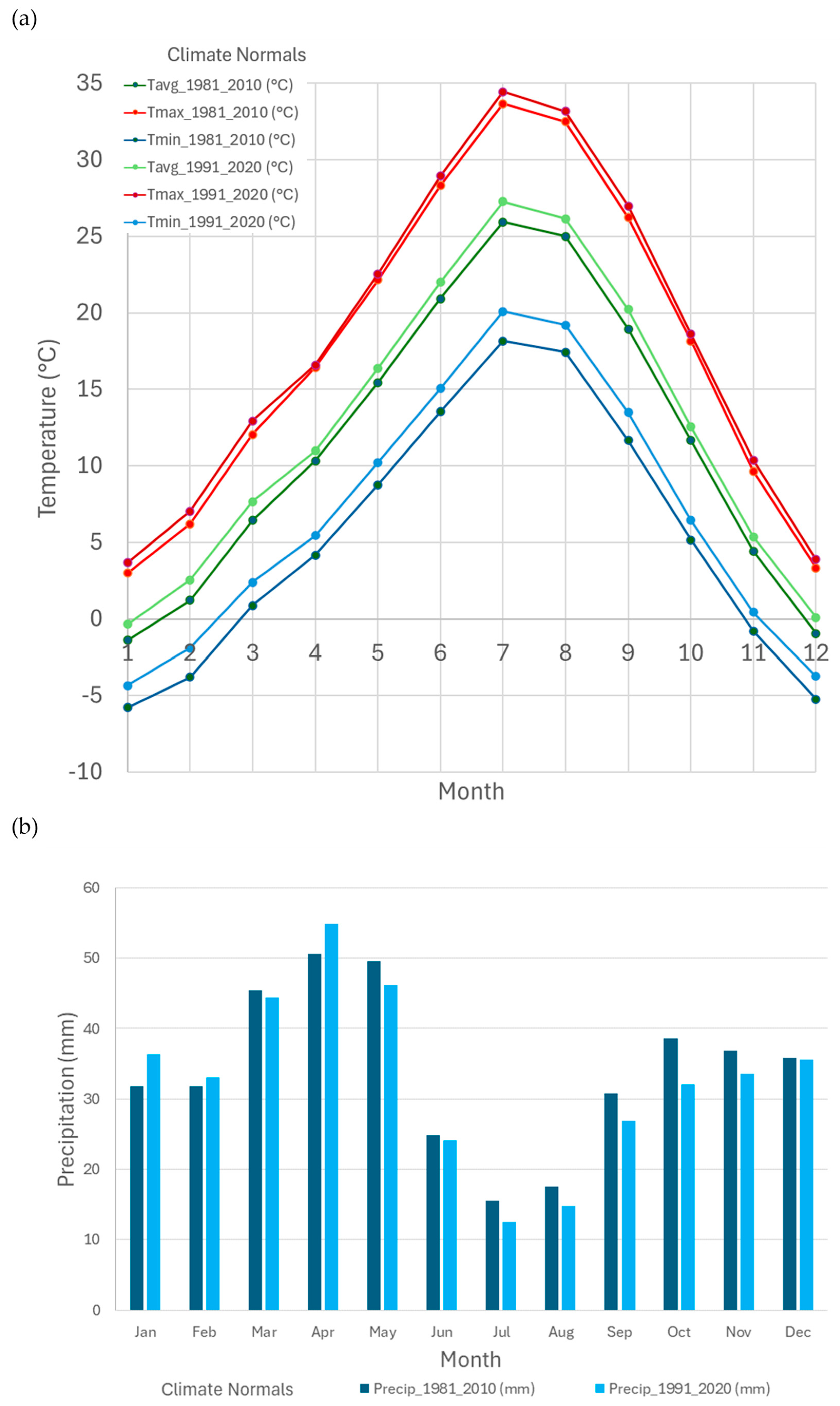


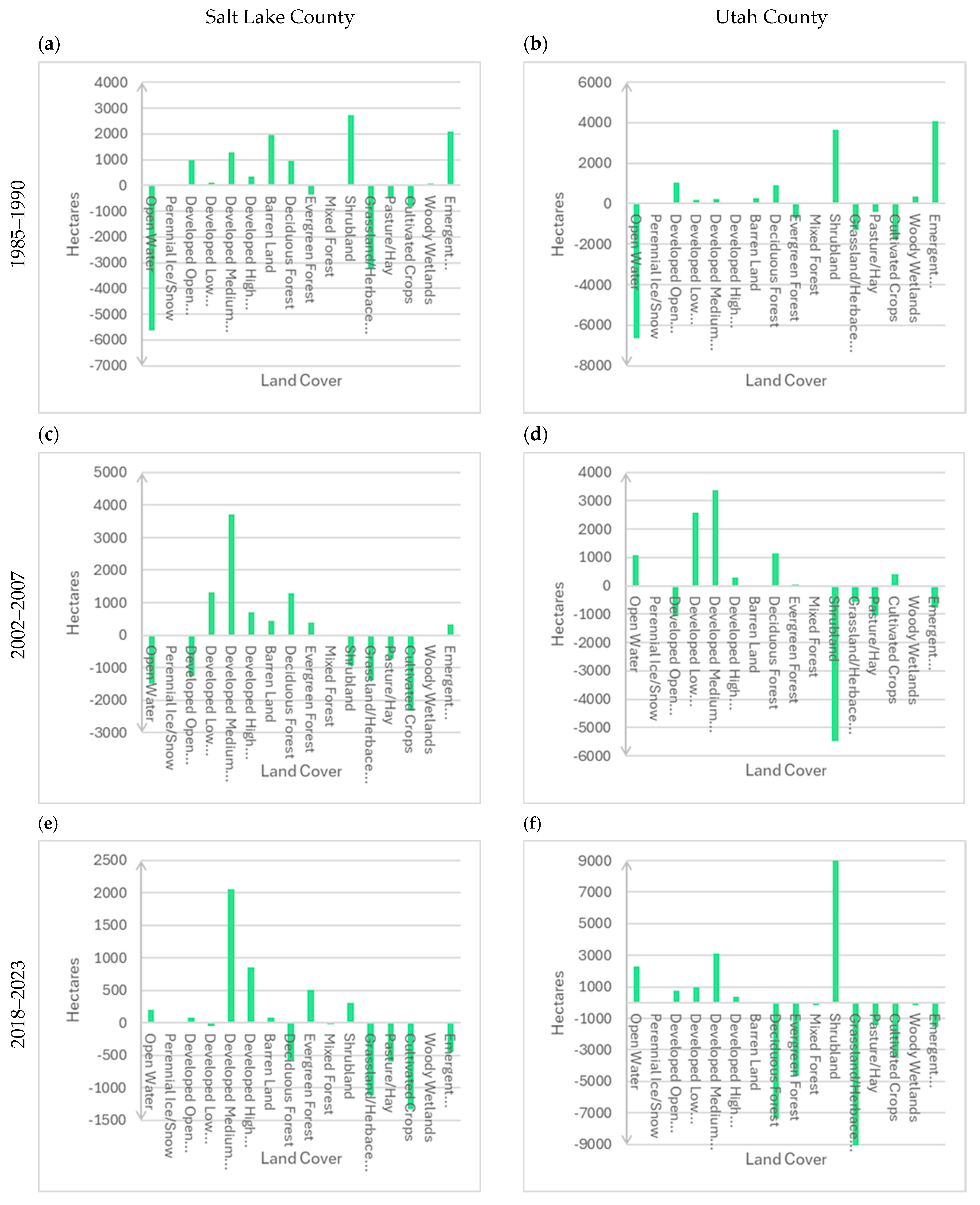
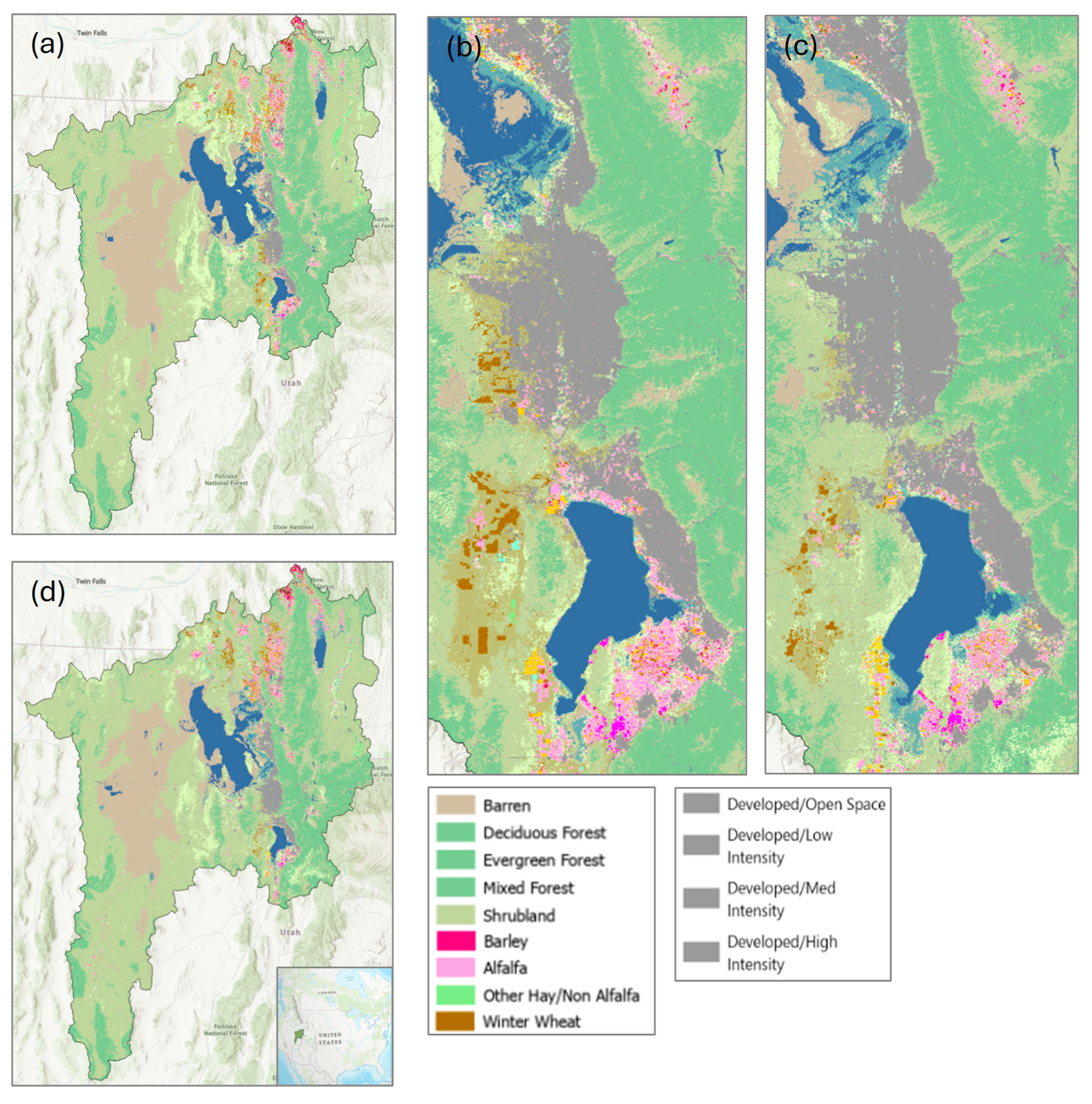
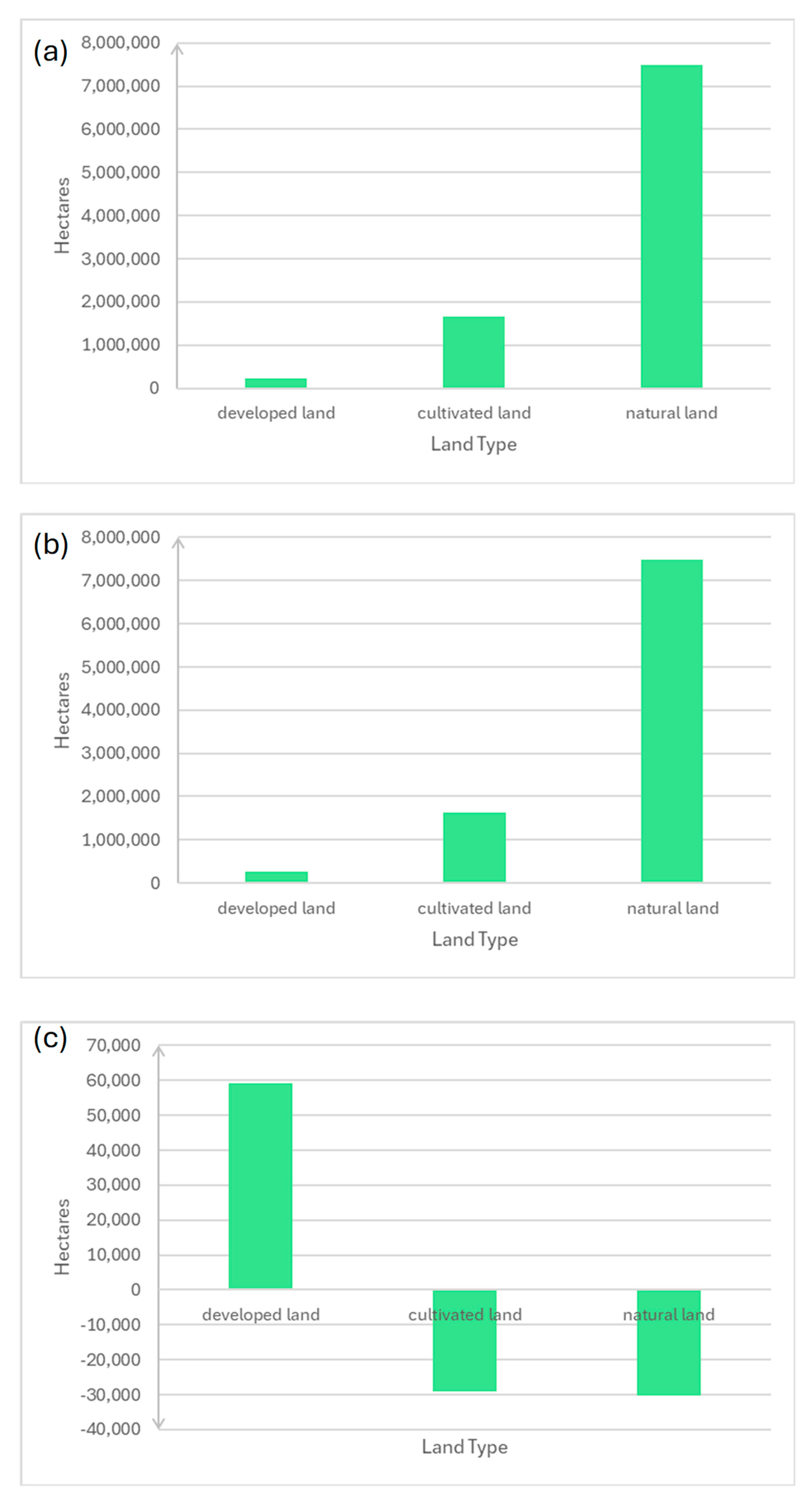
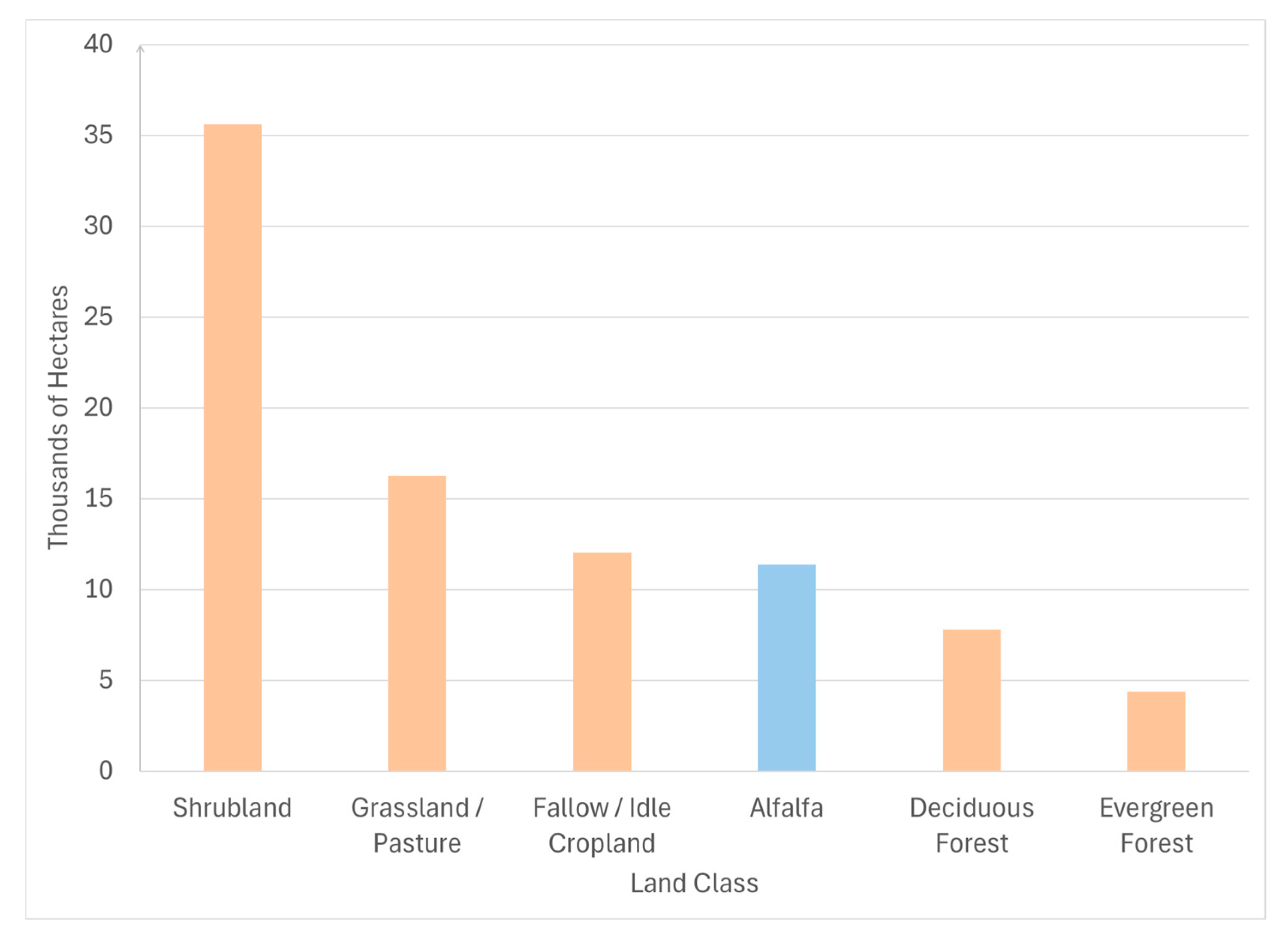
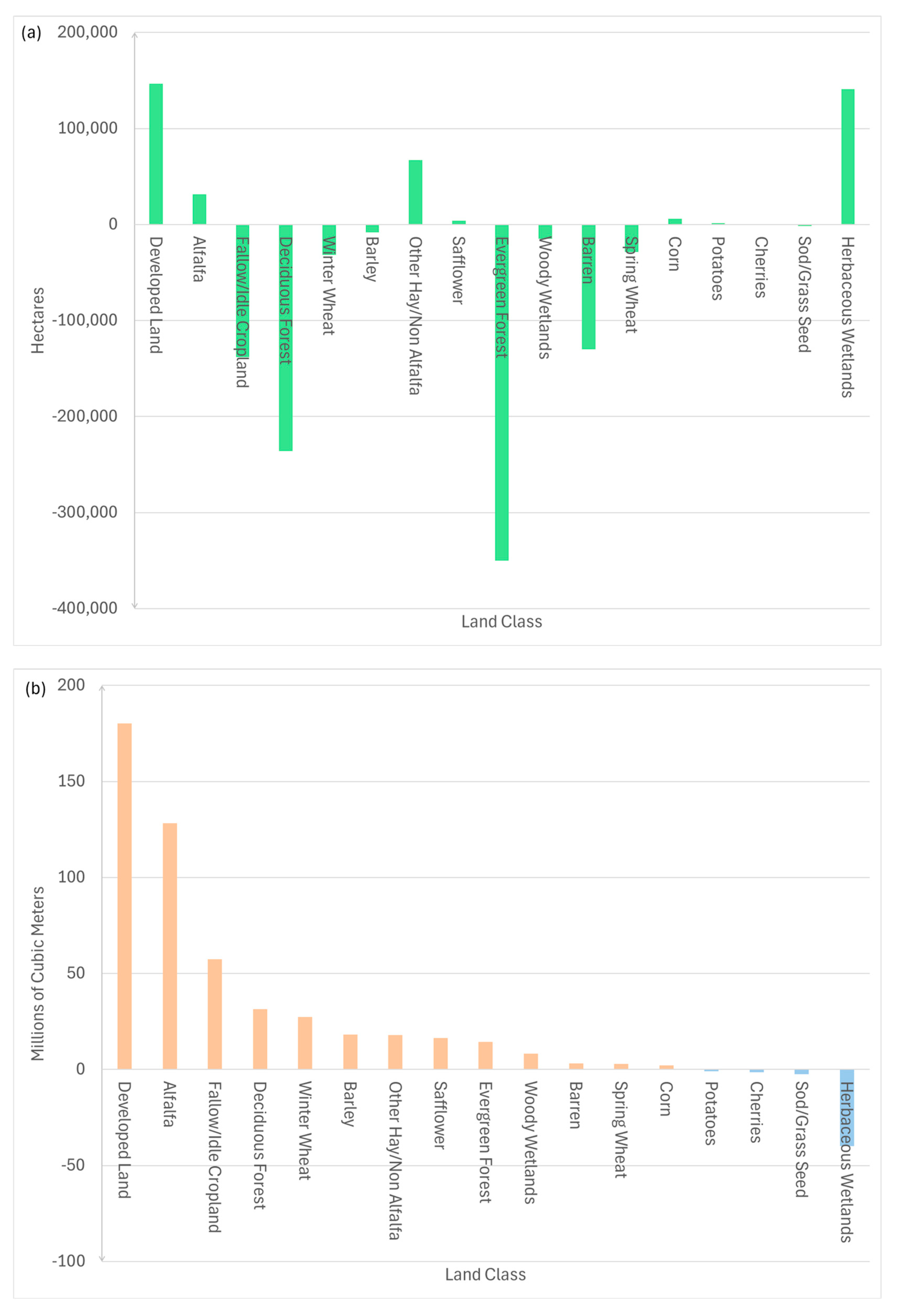
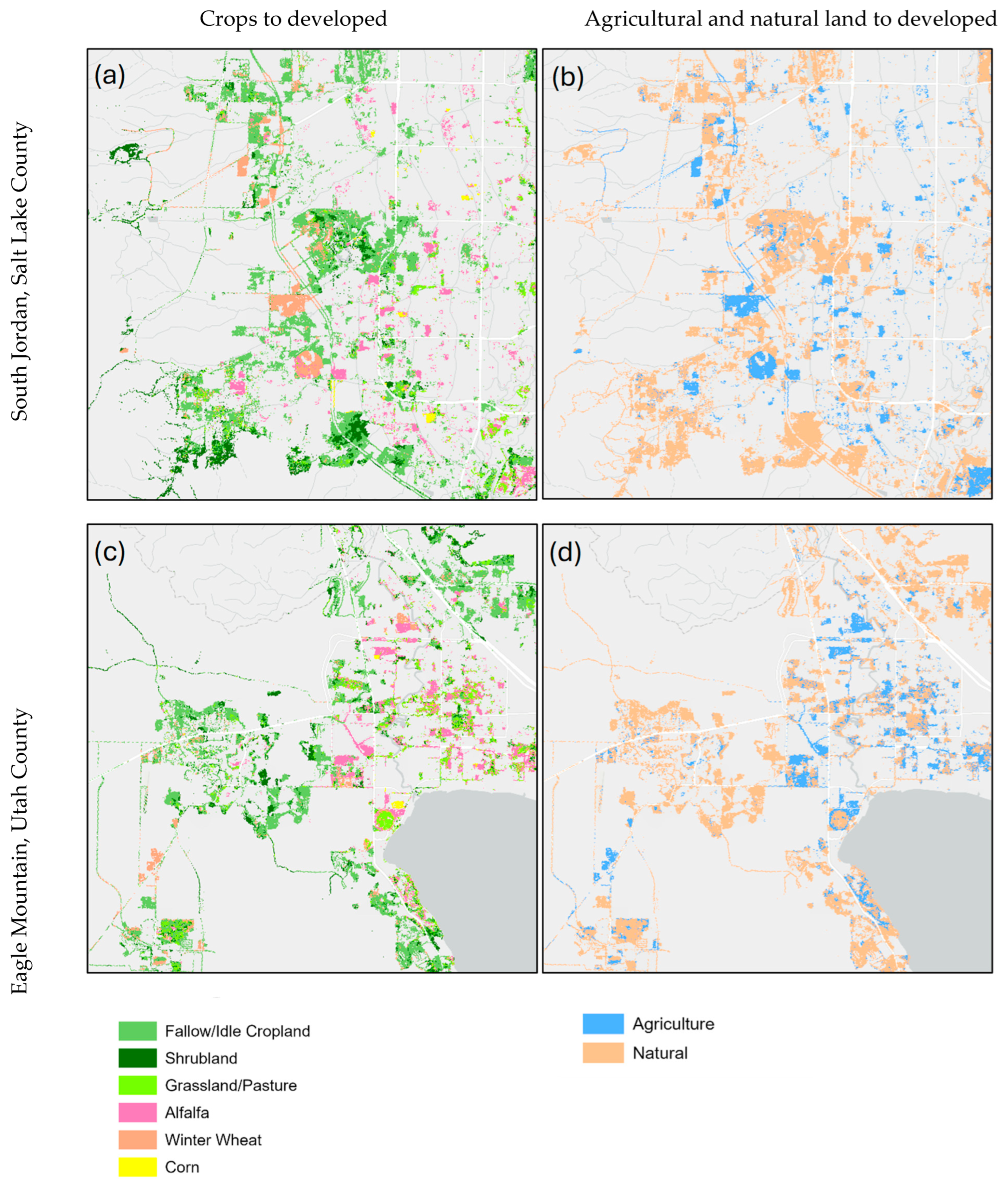

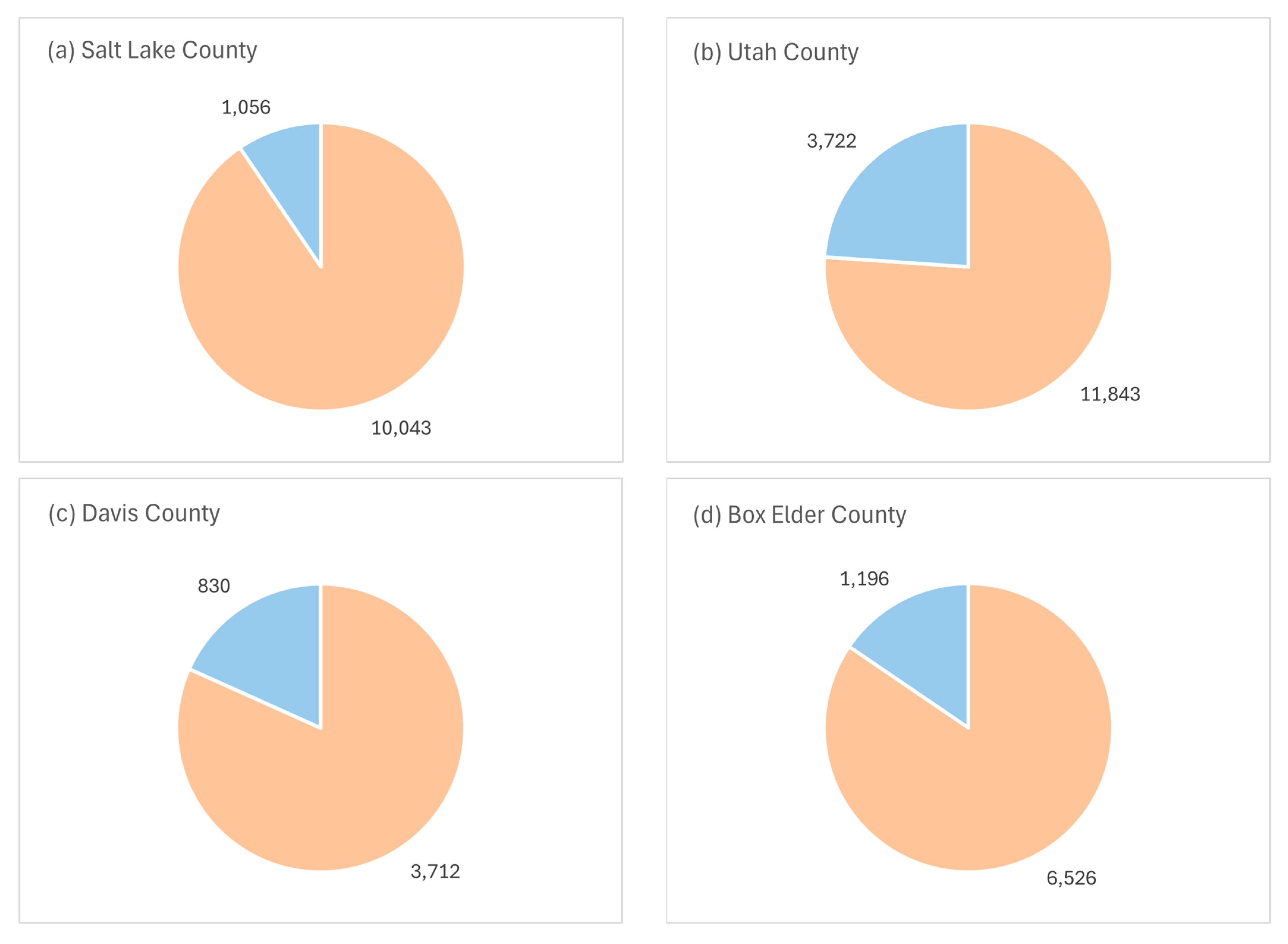

| Crop/Class Name | Annual Irrigated Water Requirement (m ha−1) |
|---|---|
| Cherries | 0.8167 |
| Safflower | 0.6773 |
| Alfalfa | 0.6636 |
| Other Hay/Non-Alfalfa | 0.5184 |
| Sod/Grass Seed | 0.5043 |
| Corn | 0.4483 |
| Spring Wheat | 0.4246 |
| Barley | 0.4002 |
| Potatoes | 0.3886 |
| Developed Land | 0.3876 |
| Winter Wheat | 0.3752 |
| Grassland/Pasture * | 0.0000 |
| Wildlands/Natural | 0.0000 |
| Month | Change in Maximum Temperature Trend Line 1985–2025 (°C) | Change in Precipitation Trend Line 1985–2025 (mm) |
|---|---|---|
| January | +2 | 0 |
| February | +1 | +5 |
| March | 0 | +17 |
| April | 0 | −5 |
| May | 0 | −15 |
| June | +2 | −8 |
| July | +2.5 | −10 |
| August | +1 | +25 |
| September | +3.5 | −5 |
| October | +0.5 | −5 |
| November | +2 | −15 |
| December | +2.5 | +20 |
| Crop/Class Name | Average Annual Irrigated Water Consumption (m3) |
|---|---|
| Alfalfa | 1,261,339,527 |
| Developed Land | 932,012,711 |
| Other Hay/Non-Alfalfa | 341,635,040 |
| Winter Wheat | 267,981,916 |
| Barley | 87,118,809 |
| Corn | 83,776,258 |
| Safflower | 74,010,963 |
| Spring Wheat | 66,129,630 |
| Sod/Grass Seed | 36,321,159 |
| Cherries | 15,137,821 |
| Potatoes | 19,870,831 |
Disclaimer/Publisher’s Note: The statements, opinions and data contained in all publications are solely those of the individual author(s) and contributor(s) and not of MDPI and/or the editor(s). MDPI and/or the editor(s) disclaim responsibility for any injury to people or property resulting from any ideas, methods, instructions or products referred to in the content. |
© 2025 by the authors. Licensee MDPI, Basel, Switzerland. This article is an open access article distributed under the terms and conditions of the Creative Commons Attribution (CC BY) license (https://creativecommons.org/licenses/by/4.0/).
Share and Cite
Howey, T.; North, L.; Kerry, R. Land Use and Land Cover Change and Potential Implications for Water Levels of the Great Salt Lake. Environments 2025, 12, 381. https://doi.org/10.3390/environments12100381
Howey T, North L, Kerry R. Land Use and Land Cover Change and Potential Implications for Water Levels of the Great Salt Lake. Environments. 2025; 12(10):381. https://doi.org/10.3390/environments12100381
Chicago/Turabian StyleHowey, Tucker, Luke North, and Ruth Kerry. 2025. "Land Use and Land Cover Change and Potential Implications for Water Levels of the Great Salt Lake" Environments 12, no. 10: 381. https://doi.org/10.3390/environments12100381
APA StyleHowey, T., North, L., & Kerry, R. (2025). Land Use and Land Cover Change and Potential Implications for Water Levels of the Great Salt Lake. Environments, 12(10), 381. https://doi.org/10.3390/environments12100381






